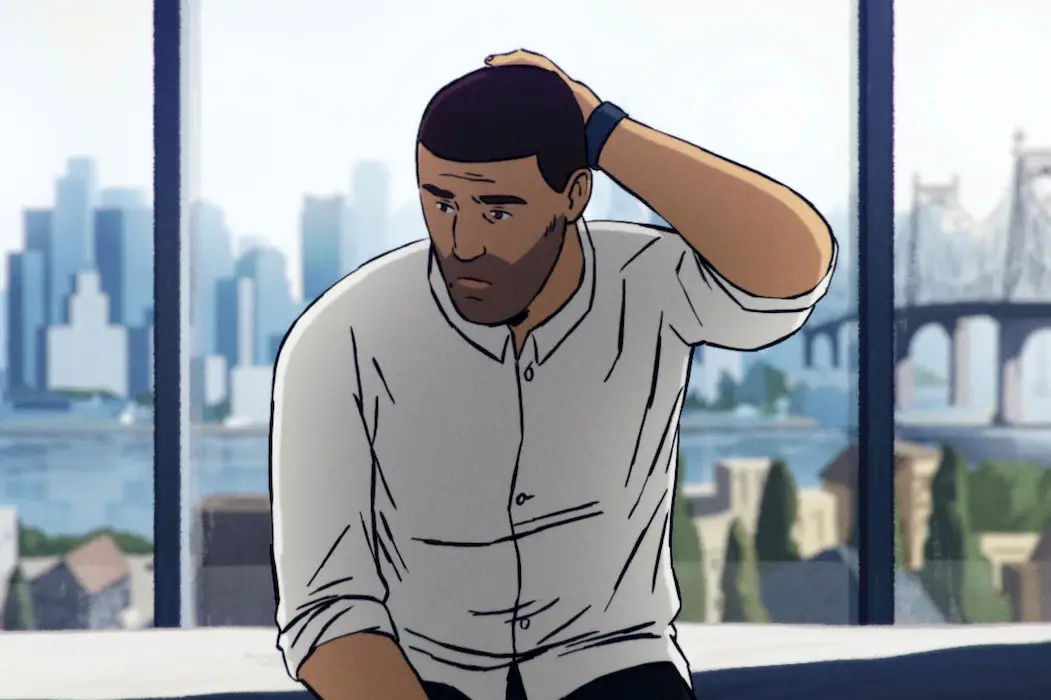TIFF 2021: FLEE: Animation as Therapy

Kevin L. Lee is an Asian-American critic, producer, screenwriter and…
Interestingly enough, this year’s Toronto International Film Festival sees not one but two animated films, in which both explore the refugee experience in a similar vein as Ari Folman’s Waltz with Bashir. But while Where is Anne Frank (ironically made by Folman himself) decides to tell its story specifically for children, Flee uses the very medium of animation as a form of therapy for both the audience and the man whose story the film is based on.
Multilayered Storytelling
Director Jonas Poher Rasmussen walks a delicate tightrope in how he tells the story in Flee. As the film opens, we are provided with text that not only are we about to be shown a true story, but that the names of the characters have been altered, in order to protect the real people involved. In this story, Rasmussen has been with his close friend Amin ever since they were high school students in Denmark. At the time, there were rumors and whispers that Amin was a child refugee from Afghanistan, but he has never opened up about his harrowing journey until now.
Slowly, at his own pace, Amin confides in Rasmussen with stories about his childhood. It is here where Flee reveals its multilayered storytelling. Though it’s classified as a documentary, the script can easily trick the average viewer into thinking it’s a narrative feature. Most of Amin’s words play over what we see as if it’s narration. He closes his eyes and is encouraged to remember every detail, which sprouts into bleak yet beautiful charcoal animation, depicting the universal struggle of survival.

At the same time, the film would occasionally take breaks and pull back to a more casual conversation between Amin and Rasmussen. Every time the film returns to its “present timeline,” we are reminded that this story is one that’s being shared and passed on from one person to another. We can only imagine how heavy the emotional weight was for Amin to carry, and how it has made him disconnected even in his current adult life. Flee introduces other minor storylines such as Amin on the verge of marrying his partner Kasper, to who he has never told his personal story. It’s another layer that adds to Amin’s childhood memories, which shows us the film is interested in more than just unlocking a haunted past.
Beautifully Realized Details and Stunning Animation
When it comes to revealing what Amin went through, the film certainly holds nothing back, and accompanying the animation is an occasional collage of archival footage to give his personal experience a greater, historical context. Like so many others who came before and after him, Amin recounts his family’s sudden escape during the Afghan Civil War, them holding out in an apartment in Moscow, avoiding corrupt Russian police, and trying every possible way to smuggle the family one at a time out of the country via human traffickers.
All these detailed memories are not only experienced by us for the first time, but they feel like Amin is experiencing them for the first time in a long time. From his descriptions, his choice of words, his way of communicating to Rasmussen, you can hear and feel how much he has repressed his pain over the years.
Meanwhile, the film presents itself with some of the most remarkable aesthetics in recent animation. Like a cross between rotoscoping and stop-motion, Flee’s animation is jagged. The frame rate is intentionally low to simulate a lack of elegance and grace. The visuals don’t appear like a movie so much as pictures that just learned how to move for the first time. This aesthetic choice allows most of Flee to feel like broken memories – a lot of them feel like still images, while others slowly take on a life of their own.
Flee: Harrowing Yet Beautiful
The animation, the narration, and the music all come together to form a therapeutic experience. The very choice of the medium allows for a more intimate, honest way to confront and accept the past for what it is and to not let it shape the present.
Flee is more than just a harrowing true journey of a gay man escaping a country at war with itself. It’s also a story of healing, to trust and feel again with the people you care about, and most of all, to be who you choose to be. None of the emotional beats in this would’ve worked without the level of trust and openness between Amin and Rasmussen. With beautiful animation, a stunning soundtrack, and an immeasurable sense of kindness to the real man who fled his home, Flee elevates both the animation and the documentary medium to new unforgettable heights.
Did you see Flee? What did you think of the film? Share below!
Flee premiered at the 2021 Toronto International Film Festival. It is scheduled to be released in theaters by NEON on December 3, 2021.
Watch Flee
Does content like this matter to you?
Become a Member and support film journalism. Unlock access to all of Film Inquiry`s great articles. Join a community of like-minded readers who are passionate about cinema - get access to our private members Network, give back to independent filmmakers, and more.
Kevin L. Lee is an Asian-American critic, producer, screenwriter and director based in New York City. A champion of the creative process, Kevin has consulted, written, and produced several short films from development to principal photography to festival premiere. He has over 10 years of marketing and writing experience in film criticism and journalism, ranging from blockbusters to foreign indie films, and has developed a reputation of being “an omnivore of cinema.” He recently finished his MFA in film producing at Columbia University and is currently working in film and TV development for production companies.













